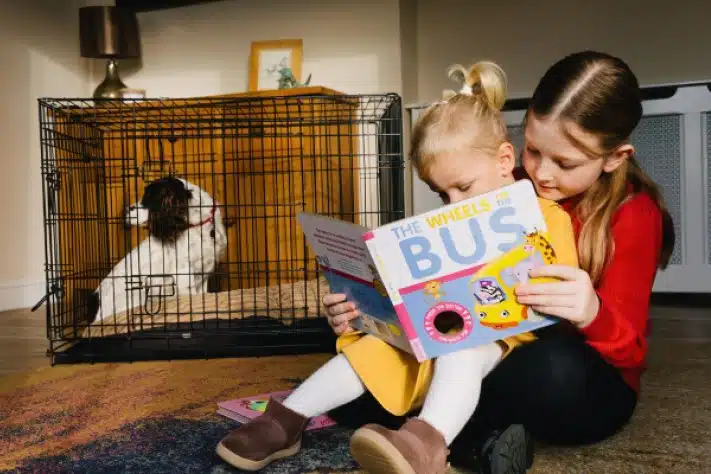5th June 2023

In support of Child Safety Week 2023, we are delighted to share a Voices blog by Emma-Jo Hill, Family Engagement Officer at Dogs Trust, on dogs, babies and children: living safely together.

Photo credit: Dogs Trust
Ensuring babies, children and dogs can live together safely is very important. Although we can have incredibly strong bonds with our dogs, and they can bring such immeasurable joy to the lives of ourselves and our children, the importance of supervising babies, children and dogs together should never be underestimated.
Believe it or not, 70% of all dog bites in the UK are to children, making them the most at-risk age group. Furthermore, 91% of bites to children occur within the home by a known dog, often their own dog, meaning supervision is crucial to prevention.
As experts agree that most bites to babies and children are preventable, Dogs Trust offers support for families on how to create a safe environment whilst also fostering stronger bonds between babies, children and dogs.
Support can be found on our ‘Dogs and children: living safely together’ webpage which is full of advice and practical tools on how to get started!
For new parents, Dogs Trust also provides further guidance on how parents can prepare their dog for a new baby and also how to safely introduce their dog to their new baby.
At Dogs Trust, we believe that bites can be prevented using three key strategies:
- Preventing unsafe child behaviours
- Understanding our dog’s needs and communication
- Implementing close supervision.
Preventing unsafe child behaviours:
When parents and carers are aware of unsafe child behaviours, they are better equipped to spot potentially unsafe situations before they become problematic. Research has identified a number of child behaviours which often precede bites and these include:
- Children preventing dogs from moving away
- Children approaching dogs at key times when they need space (for example, when they are eating, drinking, sleeping or resting)
- When children take away important resources such as toys or something the dog is enjoying.
Perhaps more surprisingly, however, is that it is often loving, well–intentioned behaviours which babies and children perform, that can make dogs feel uncomfortable, and lead to a bite occurrence. These behaviours include:
- Hugging or kissing the dog
- Leaning over the dog
- Stroking the dog
- Putting their face too close to the dog’s face
It is more often these behaviours that parents are unaware of that go unnoticed, even when parents are supervising. If all of the above behaviours are spotted and stopped, however, a reduction in dog bites is much more likely.
Understanding dog’s needs and communication:
In addition to being aware of baby and child behaviours, having a better understanding of a dog’s needs and how they communicate can be pivotal in recognising when a dog is uncomfortable in a situation. It means we can give dogs the space they need to decompress and the choice to move away from any situation that makes them feel uncomfortable or worried.
Implementing Close Supervision:
The three Ss of close supervision:
- Staying close: Watch, listen, and remain close during baby/child-dog interactions, as each action alone is unlikely to be sufficient.
- Stepping In: Intervene when either the baby, child or dog looks uncomfortable by physically separating them in a calm and gentle way. This can be done by stopping a behaviour, increasing space between them, or fully separating the two.
- Separating: When you are likely to be preoccupied or distracted, fully separate the baby or child and dog by putting them in separate rooms or using a physical barrier such as a baby gate or playpen.
Health visitors have an important role to play in reducing dog bites by ensuring that all families understand the risks and are aware of these three key strategies for keeping babies and children safe. We recognise that, for parents, being there during all baby/child and dog interactions is a big ask. However, close supervision can be made easier when parents know what behaviours to look out for and how to better understand when dogs are uncomfortable and are in need of space.
At Dogs Trust, we advise parents to start by introducing small, easy-to-implement changes which can make their home safer for everyone. Tips and advice can be found on our webpage which offers further information, as well as access to our action plans, online manual, and sign up to our FREE online webinar.


